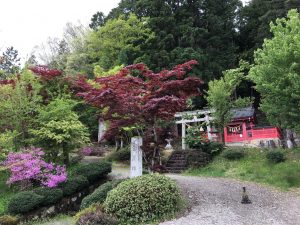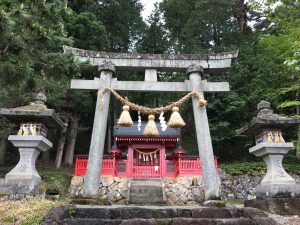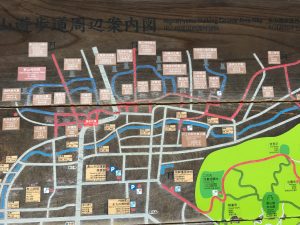This is a lovely small town, and there’s so much to see nearby; it’s unfortunate when time is limited! We set off this morning for Hika No Sato, a folk village just to the south of the railway station. The hotel desk clerk sent us off beyond the turn, but that allowed us to see little streets and gardens and rice fields, and eventually we found our way back to the right road and headed up the hill.
Opened in 1971 for the purpose of preserving traditional houses and lifestyles, and to pass the cultural heritage to further generations, I soon felt like I was in a Disney re-creation. More than 30 buildings were moved from different parts of the Hida region, inclusion Gassho styoe thatched roof houses, shingled roof houses and others. Various kinds of daily tools and articles are displayed in houses from different time periods, and occasionally there are artisans at work. There was one shrine with special artwork painted on the ceiling that was only open to view twice a year; I tried to snap a photo through the chicken wire. However, after about the 4th house I felt a little “theme-parked” and resorted to watching the lone swan in the lake. It was interesting but only to a point, and then I was ready to go!
The area surrounding this village has some lovely craft shops and cafes, so we found a spot for lunch and managed the tatami mats in a traditional Japanese setting. On our walk out of the area we came across school children walking in a line — led by older children with flags, but all in taxi-yellow caps and matching umbrellas. We passed a bakery that smelled like France and bought pastries and headed back towards the hotel to re-group and plan the afternoon.
Karen was interested in the Takayama Yati Kaikan, where they display several of the large colorful floats used in the two festivals in town each year. Dating from the 17th and 18th C, the floats are richly decorated with gleaming lacquer, gilt and mother-of-pearl inlays, along with lanterns and drapes and mechanized figures and are paraded through town during the spring and fall festivals related to various deities who are coming to town at certain times of the year. I wanted to walk the Higashiyama Walking Course of temples and shrines; so we agreed to meet for dinner and headed in our different directions.
The history of modern Takayama dates back to 1586, when Hagachika Kanamori, a feudal lord, took control of the Hida region. As he completed the construction of the Takayama Castle, he designated the higher ground around the castle for samurai and the lower ground for the merchants (now the Old Town). In the eastern hills the temples and shrines were build or re-located from other places. As a result there’s a walking track of about 5km which allows people to see a number of historical sites and the surrounding forest. It was peaceful, with almost no other visitors along the path, and while it might be easy to get “templed-out”, I enjoyed the quiet and the gates and the sculptures and the bells. It threatened to rain but didn’t, so it was possible to see about a dozen temples and shrines, as well as several cemeteries.
With some time to kill before meeting for dinner, I headed to the Takayama Museum of History and Art, which was free and still open! The various exhibition rooms covered everything from the history, to festivals, education, crafts, religion and economics of Takayama. Most interesting to me was the work by Enku, a Buddhist monk in the 17th C who wandered all over Japan carving wooden statues of Buddha along the way. There are over 4,000 of his works throughout Japan, many of which were crudely carved and lacked any sense of refinement. His works can be found at temples, shrines and at the residences of local farmers and were a source of faith to the people who referred to them as Enku sama.
Dinner was at a traditional Japanese restaurant and Hida beef shabu shabu style. Nothing better to accompany sake. And randomly, some examples of how best to re-use, re-cycle, in the form of some art handing outside a small home. Brilliant.
We are off tomorrow to begin our Kumano Koda trek. We are to meet a representative of the company arranging our accommodations and luggage transport in Kii-Tanabe at 4:30, so it will be an early (and multiple) train day. And then we are walking!

















